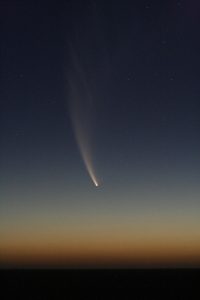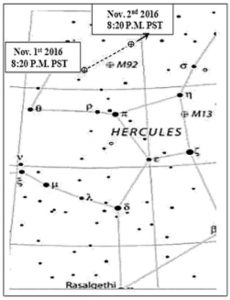A comet hunter on Saipan
Image Credit: Dr. Norm

It’s a pretty much known fact that I am a big astronomy geek here in the Northern Mariana Islands and even Guam. Less than a handful of astronomy geeks like myself live here on the islands and I might be the only real astronomy geek living here on Saipan. That fact makes me feel a little insecure at times, especially when I enjoy talking about astronomy or current astronomical events with someone. So what do I do to keep myself totally focused (pardon the pun) on astronomy on my stargazing nights on Saipan? Answer: Search for comets. Yup, besides just stargazing, my major astronomical interest and goal is to discover a new comet here on the island of Saipan using my trusty new alt-azimuth mounted 90mm Mystery telescope
Starting with the summer skies, I avoid searching the Milky Way. There are just too many celestial objects in the Milky Way that resemble a comet. A comet usually appears as a faint “smudge” in the telescope’s eyepiece field of view. The Milky Way is filled with these “smudges” (hundreds of them). Most of them are faint, small, condensed globular star clusters that can fool even the most experienced comet hunters if they didn’t check out each one individually when they see it in their telescope’s eyepiece field of view. That would be too time-consuming and end up as a futile search for discovery of a new comet.
Most new comets are usually discovered around 10th magnitude, usually discovered as a photographic or visual celestial object (usually a smudge with or without a tail), which is within the magnitude range of my humble 90mm Mystery telescope, providing I’m using a 20mm to 25mm eyepiece, 2x Barlow lens and my Pocket Sky Atlas to confirm it’s actual position in any particular constellation using Right Ascension and Declination (R.A. and Dec.) coordinates.

The naked eye can see stars down to the 6th magnitude under clear dark skies. If I get real lucky and spot a “smudge” in my telescope’s eyepiece field of view on any given night and determine it has moved by the next night. See comet movement example in the Constellation Hercules sky chart:
I will start to get excited and send a fax and/or email of my suspected new comet coordinates (its astronomical position) and its discovery data to an observatory in Australia or Hawaii for confirmation first. Then, if they confirm it to be a new comet, I will then send a fax and/or email the observatory’s confirmation and my new comet discovery data to Central Bureau for Astronomical Telegrams. If they confirm it too, then I can celebrate with a discovery of a new comet. Hopefully, a new comet discovery is in the near future here on Saipan. That’s my goal.
I usually start my comet searching on clear moonless nights or after the moon sets soon after midnight. That’s generally the best time to search the skies after the surrounding lights have all been turned off and when the night sky will be best suited for scanning the heavens for a new comet. “If” I am successful in my new comet search, it will be my very first new comet discovery and will be the first new comet discovered in the Northern Mariana Islands (including Guam) on the island of Saipan. A new comet discovery will focus important worldwide attention on Saipan and put it on the honorable astronomical map forever. Wish me luck!

P.S. It would be absolutely great if there was a small observatory (local government-funded and/or NASA grant) complete with a modern all-computerized refractor telescope that is built and located permanently at the Northern Marianas College campus that would be used for academic, student research, solar studies and other university astronomical programs as well. What a great way to encourage the Northern Marianas College and high school students to pursue future academic and professional careers in the sciences, especially physics and astronomy.
***
Norman Butler Ph.D. is a retired astronomer and has been a Saipan resident since 2011. Butler, who holds advanced degrees in Physics and Astronomy, was an opticalman (submarine optical navigational equipment) in the U.S. Navy throughout the 1960s and worked at Haleakala’s AMOS Observatory on Maui starting in the 1980s. He has also authored four popular books on binoscopes and taught at Shenzhen Polytechnic College and Harbin Institute of Technology Shenzhen Graduate School in Shenzhen, China.




